+ Open data
Open data
- Basic information
Basic information
| Entry | Database: PDB / ID: 5zkt | ||||||
|---|---|---|---|---|---|---|---|
| Title | Crystal structure of TCP domain of PCF6 in Oryza sativa | ||||||
 Components Components | Putative transcription factor PCF6 | ||||||
 Keywords Keywords | TRANSCRIPTION / TCP domain / OsPCF6 | ||||||
| Function / homology |  Function and homology information Function and homology informationregulation of secondary shoot formation / sequence-specific DNA binding / DNA-binding transcription factor activity / nucleus Similarity search - Function | ||||||
| Biological species |  | ||||||
| Method |  X-RAY DIFFRACTION / X-RAY DIFFRACTION /  SYNCHROTRON / SYNCHROTRON /  SAD / Resolution: 1.74 Å SAD / Resolution: 1.74 Å | ||||||
 Authors Authors | Sun, L.F. / Zou, X.M. / Wu, Y.K. | ||||||
| Funding support |  China, 1items China, 1items
| ||||||
 Citation Citation |  Journal: To be published Journal: To be publishedTitle: Crystal structure of TCP domain of PCF6 in Oryza sativa Authors: Sun, L.F. / Zou, X.M. | ||||||
| History |
|
- Structure visualization
Structure visualization
| Structure viewer | Molecule:  Molmil Molmil Jmol/JSmol Jmol/JSmol |
|---|
- Downloads & links
Downloads & links
- Download
Download
| PDBx/mmCIF format |  5zkt.cif.gz 5zkt.cif.gz | 35.2 KB | Display |  PDBx/mmCIF format PDBx/mmCIF format |
|---|---|---|---|---|
| PDB format |  pdb5zkt.ent.gz pdb5zkt.ent.gz | 22.9 KB | Display |  PDB format PDB format |
| PDBx/mmJSON format |  5zkt.json.gz 5zkt.json.gz | Tree view |  PDBx/mmJSON format PDBx/mmJSON format | |
| Others |  Other downloads Other downloads |
-Validation report
| Summary document |  5zkt_validation.pdf.gz 5zkt_validation.pdf.gz | 423.3 KB | Display |  wwPDB validaton report wwPDB validaton report |
|---|---|---|---|---|
| Full document |  5zkt_full_validation.pdf.gz 5zkt_full_validation.pdf.gz | 423.3 KB | Display | |
| Data in XML |  5zkt_validation.xml.gz 5zkt_validation.xml.gz | 7 KB | Display | |
| Data in CIF |  5zkt_validation.cif.gz 5zkt_validation.cif.gz | 9.1 KB | Display | |
| Arichive directory |  https://data.pdbj.org/pub/pdb/validation_reports/zk/5zkt https://data.pdbj.org/pub/pdb/validation_reports/zk/5zkt ftp://data.pdbj.org/pub/pdb/validation_reports/zk/5zkt ftp://data.pdbj.org/pub/pdb/validation_reports/zk/5zkt | HTTPS FTP |
-Related structure data
| Similar structure data |
|---|
- Links
Links
- Assembly
Assembly
| Deposited unit | 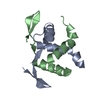
| ||||||||
|---|---|---|---|---|---|---|---|---|---|
| 1 |
| ||||||||
| Unit cell |
|
- Components
Components
| #1: Protein | Mass: 6218.169 Da / Num. of mol.: 2 / Fragment: TCP domain Source method: isolated from a genetically manipulated source Source: (gene. exp.)  Gene: B1364A02.22, OJ1048_C10.23 / Plasmid: pET32a / Production host:  #2: Water | ChemComp-HOH / | |
|---|
-Experimental details
-Experiment
| Experiment | Method:  X-RAY DIFFRACTION / Number of used crystals: 1 X-RAY DIFFRACTION / Number of used crystals: 1 |
|---|
- Sample preparation
Sample preparation
| Crystal | Density Matthews: 2.66 Å3/Da / Density % sol: 53.79 % |
|---|---|
| Crystal grow | Temperature: 289 K / Method: vapor diffusion, hanging drop / pH: 4.6 Details: 0.2 M Ammonium sulfate, 0.1 M Sodium acetate pH4.6, 30% (w/v) PEG1500 |
-Data collection
| Diffraction | Mean temperature: 100 K / Serial crystal experiment: N | ||||||||||||||||||||||||||||||
|---|---|---|---|---|---|---|---|---|---|---|---|---|---|---|---|---|---|---|---|---|---|---|---|---|---|---|---|---|---|---|---|
| Diffraction source | Source:  SYNCHROTRON / Site: SYNCHROTRON / Site:  SSRF SSRF  / Beamline: BL17U1 / Wavelength: 0.979 Å / Beamline: BL17U1 / Wavelength: 0.979 Å | ||||||||||||||||||||||||||||||
| Detector | Type: ADSC QUANTUM 315r / Detector: CCD / Date: May 1, 2017 | ||||||||||||||||||||||||||||||
| Radiation | Protocol: SINGLE WAVELENGTH / Monochromatic (M) / Laue (L): M / Scattering type: x-ray | ||||||||||||||||||||||||||||||
| Radiation wavelength | Wavelength: 0.979 Å / Relative weight: 1 | ||||||||||||||||||||||||||||||
| Reflection | Resolution: 1.74→72.37 Å / Num. obs: 13997 / % possible obs: 98 % / Redundancy: 14 % / CC1/2: 0.999 / Rmerge(I) obs: 0.057 / Rpim(I) all: 0.016 / Rrim(I) all: 0.059 / Net I/σ(I): 27.7 / Num. measured all: 196470 / Scaling rejects: 2 | ||||||||||||||||||||||||||||||
| Reflection shell | Diffraction-ID: 1
|
- Processing
Processing
| Software |
| ||||||||||||||||||||||||||||||||||||||||||
|---|---|---|---|---|---|---|---|---|---|---|---|---|---|---|---|---|---|---|---|---|---|---|---|---|---|---|---|---|---|---|---|---|---|---|---|---|---|---|---|---|---|---|---|
| Refinement | Method to determine structure:  SAD / Resolution: 1.74→37.415 Å / SU ML: 0.17 / Cross valid method: THROUGHOUT / σ(F): 1.36 / Phase error: 23.77 / Stereochemistry target values: ML SAD / Resolution: 1.74→37.415 Å / SU ML: 0.17 / Cross valid method: THROUGHOUT / σ(F): 1.36 / Phase error: 23.77 / Stereochemistry target values: ML
| ||||||||||||||||||||||||||||||||||||||||||
| Solvent computation | Shrinkage radii: 0.9 Å / VDW probe radii: 1.11 Å / Solvent model: FLAT BULK SOLVENT MODEL | ||||||||||||||||||||||||||||||||||||||||||
| Displacement parameters | Biso max: 65.93 Å2 / Biso mean: 32.5724 Å2 / Biso min: 17.5 Å2 | ||||||||||||||||||||||||||||||||||||||||||
| Refinement step | Cycle: final / Resolution: 1.74→37.415 Å
| ||||||||||||||||||||||||||||||||||||||||||
| Refine LS restraints |
| ||||||||||||||||||||||||||||||||||||||||||
| LS refinement shell | Refine-ID: X-RAY DIFFRACTION / Rfactor Rfree error: 0 / Total num. of bins used: 5
|
 Movie
Movie Controller
Controller





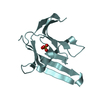

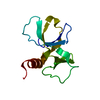
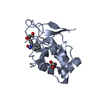



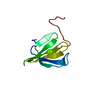
 PDBj
PDBj
